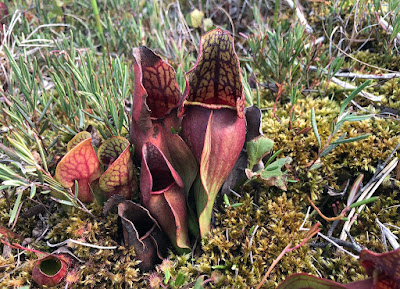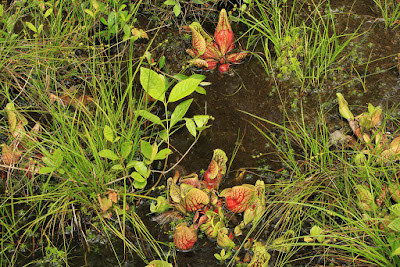Purple pitcher plant is the hardiest and most widespread of the eight pitcher plants native to North America and the only species whose range extends into the boreal zone. In North America it grows in ombrotrophic bogs, poor fens, and seepage mires throughout Canada east of the Rocky Mountains and along the Atlantic coast of the United States from Maine south to Florida and the extreme southeast of Mississippi.
Purple pitcher plant also called as Sarracenia purpurea, Northern pitcher plant, turtle socks, side - saddle flower, is a carnivorous plant of the genus Sarracenia. This species was described by Carl Linnaeus in 1753.
IDENTIFY PURPLE PITCHER PLANT - SARRACENIA PURPUREA
Purple pitcher plant is the hardiest and most widespread of the eight pitcher plants native to North America and the only species whose range extends into the boreal zone. In North America it grows in ombrotrophic bogs, poor fens, and seepage mires throughout Canada east of the Rocky Mountains and along the Atlantic coast of the United States from Maine south to Florida and the extreme southeast of Mississippi.
Sarracenia purpurea is a perennial herb with leaves modified into inflated pitchers. The pitchers are 5 - 45 cm long, often resting on the ground, green with purple veins; widest at the middle, with a wing on the upper side and an erect, wavy-edged hood; pitchers persist through the winter.
Individual plants consist of several cup-shaped leaves that fill with rain water and passively capture insect prey. Insects are attracted by nectar or scent and fall and drown in the pitcher. In north Florida, the prey almost entirely consists of ants. The leaves also serve as habitat for an aquatic community called a phytotelma or inquiline community. The community consists of bacteria, protozoa, rotifers, mites and the larvae of three dipteran species, Blaesoxipha fletcheri,Wyeomyia smithii and Metriocnemus knabi. The phytotelma community is considered to be the primary mechanism by which the plant receives nutrients from carnivory: as prey decomposes due to the activities of the community, nutrients are released into the water and absorbed by the leaf.
Northern pitcher plant blooms April–May from 15 - 70 cm tall, leafless flower stalk. The flower consisting of 5 persistent sepals, 5 petals, a single pistil with a large umbrella-shaped style, and numerous stamens. The sepals and petals are usually reddish purple (rarely yellowish green), while the persistent style is yellowish green.
Some varieties and clones: Sarracenia purpurea subsp. purpurea; Sarracenia purpurea subsp. purpurea f. heterophylla; Sarracenia purpurea subsp. venosa; Sarracenia purpurea subsp. venosa var. burkii; Sarracenia purpurea subsp. venosa var. burkii f. luteola; Sarracenia purpurea subsp. venosa var. montana.
PURPLE PITCHER PLANT - SARRACENIA PURPUREA CARE AND CULTURE
Cultural information should only be used as a guide, and should be to be adapted to suit you. Your physical location; where you grow your plants, how much time you have to devote to their care, and many other factors, will need to be taken into account. Only then can you decide on the cultural methods that best suit you and your plants.
Light and temperature:
Purple pitcher plant must be grown in full sun so that the plant is vigorous and beautiful color. In summer, the plants are grow at the temperature of 15-30°C. In winter, it can withstand the temperature of -10°C. Seed germination requires a period of winter dormancy, followed by a period of warm moist conditions.
Substrate, growing media and repotting:
Sarracenia purpurea can be grown successfully in a plastic basin or in a pot that is standing in a deep saucer of water. It can grow on 100% blonde peat, and in very poor soil and acid, but the ideal substrate is 70% peat, 15% sand and 15% vermiculite.
Watering:
In summer, watering should be frequent. In winter, the plant is not afraid that the water in the pitchers will freeze, on the contrary; it is beneficial for the plant because it teaches it to resist more cold. During the winter period, water it sparingly, because if it has too much water the crystallization is faster so the substrate freezes, but it does not fear that the substrate freezes completely.
Feeding:
Do not fertilize the plants. Kept outside, the plant will catch more than enough food for themselves. If you keep your plants indoors, you can feed them with dried insects every few weeks.
Propagation:
Sarracenia purpurea can be propagated by seed or division.

















COMMENTS